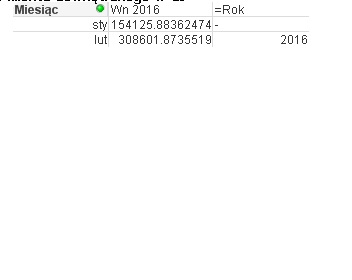Unlock a world of possibilities! Login now and discover the exclusive benefits awaiting you.
- Qlik Community
- :
- All Forums
- :
- QlikView App Dev
- :
- Range Sum - cummulative sums with limit date using...
- Subscribe to RSS Feed
- Mark Topic as New
- Mark Topic as Read
- Float this Topic for Current User
- Bookmark
- Subscribe
- Mute
- Printer Friendly Page
- Mark as New
- Bookmark
- Subscribe
- Mute
- Subscribe to RSS Feed
- Permalink
- Report Inappropriate Content
Range Sum - cummulative sums with limit date using set analysis
Hi Developers,
I'm trying to do cummulative sums for 12 months in bar chart within specific year regardless current selected month:
MO_ID is kind of sum.
Month = Miesiac
sty - Jan
lut - Feb...
...gru - Dec
My expression:
=sum({$<Month=>}aggr(rangesum( ABOVE( sum({$<ID_Month= {"<=$(=Max({1} ID_Miesiąc))"}, Month=, MO_ID={1}>}Amount),0,12) ),ID_Month))
This is working like this:

When i have 2016 i am limited with max ID_Month - 2 (it is the last closed month)
-
=sum({$<Month=, ID_Month={'<=2'}>}aggr(rangesum( ABOVE( sum({$<ID_Month= {"<=$(=Max({1} ID_Miesiąc))"}, Month=, MO_ID={1}>}Amount),0,12) ),ID_Month)
Result with this expression is:

And this result above i would to get in my chart but only in 2016. As you can see above -
I have year 2016 in lut - February so when i set the expression if(Year='2016',...) this will be working only in one row,
i want them all in 2016.
Please save me and help me,
thank you in advance !
Jacek Antek
- « Previous Replies
-
- 1
- 2
- Next Replies »
Accepted Solutions
- Mark as New
- Bookmark
- Subscribe
- Mute
- Subscribe to RSS Feed
- Permalink
- Report Inappropriate Content
This should show the year in all dimension lines
=Only({<Miesiąc=>}Rok)
But maybe you just need to filter in your set expression instead of using an if() statement, like
=sum({$<Miesiąc=, ID_Miesiąc={'<=2'}, Rok *= {2016}>}aggr(rangesum( ABOVE( sum({$<ID_Miesiąc= {"<=$(=Max({1} ID_Miesiąc))"}, Miesiąc=, MO_ID={1}>}KwotaW),0,12) ),Rok,ID_Miesiąc))
or use conditional expressions?
- Mark as New
- Bookmark
- Subscribe
- Mute
- Subscribe to RSS Feed
- Permalink
- Report Inappropriate Content
I think that's because a grain mismatch between your aggr() dimensions and the outer chart dimensions (read Henric's blog post about aggr() pitfalls if you need to understand the grain mismatch), try
=sum({$<Month=, ID_Month={'<=2'}>}aggr(rangesum( ABOVE( sum({$<ID_Month= {"<=$(=Max({1} ID_Miesiąc))"}, Month=, MO_ID={1}>}Amount),0,12) ),Year, ID_Month)
- Mark as New
- Bookmark
- Subscribe
- Mute
- Subscribe to RSS Feed
- Permalink
- Report Inappropriate Content
Perhaps this document helps: Calculating rolling n-period totals, averages or other aggregations
I think your expression is missing at least something that makes it ignore the selection of the year and something to aggregate per month per year instead of just over months. Can you post a small qlikview document that demonstrates the problem?
talk is cheap, supply exceeds demand
- Mark as New
- Bookmark
- Subscribe
- Mute
- Subscribe to RSS Feed
- Permalink
- Report Inappropriate Content
Thank You swuehl.
I have tried your solution but it didn't work.
Im wondering if i had flagYear in model it would solve my problem.
- Mark as New
- Bookmark
- Subscribe
- Mute
- Subscribe to RSS Feed
- Permalink
- Report Inappropriate Content
Maybe I just don't understand your data model. Why do you have year 2016 only in lut?
Would you be able to share a small sample?
- Mark as New
- Bookmark
- Subscribe
- Mute
- Subscribe to RSS Feed
- Permalink
- Report Inappropriate Content
MY file has 84 mb, how can i do from it small sample ? ![]()
- Mark as New
- Bookmark
- Subscribe
- Mute
- Subscribe to RSS Feed
- Permalink
- Report Inappropriate Content
Please don't upload a file this large, just create a small sample QVW with some (best INLINE) tables that show how relevant fields and tables are related and how your data looks like (could be mock up data).
You only need to create the relevant fields to demonstrate your setting and issue (I know it's not easy to tell what's relevant, as soon as you've mastered this, you probably also mastered to resolve the issue on your own ![]() )
)
- Mark as New
- Bookmark
- Subscribe
- Mute
- Subscribe to RSS Feed
- Permalink
- Report Inappropriate Content
Select some values in your document and then choose the Reduce option from the File menu and choose Keep Possible Values. Then save the document so it contains only the reduced data set.
talk is cheap, supply exceeds demand
- Mark as New
- Bookmark
- Subscribe
- Mute
- Subscribe to RSS Feed
- Permalink
- Report Inappropriate Content
Ok,
so my file has only 7.7 mb right now ![]()
Dictionary for you Guys:
Miesiąc - Month
Rok - Year
ID_Miesiąc = ID_Month
KwotaW - Amount.
Thank you for your support.
Jacek Antek
- Mark as New
- Bookmark
- Subscribe
- Mute
- Subscribe to RSS Feed
- Permalink
- Report Inappropriate Content
I can't open the QVW, seems like there is section access enabled.
- « Previous Replies
-
- 1
- 2
- Next Replies »